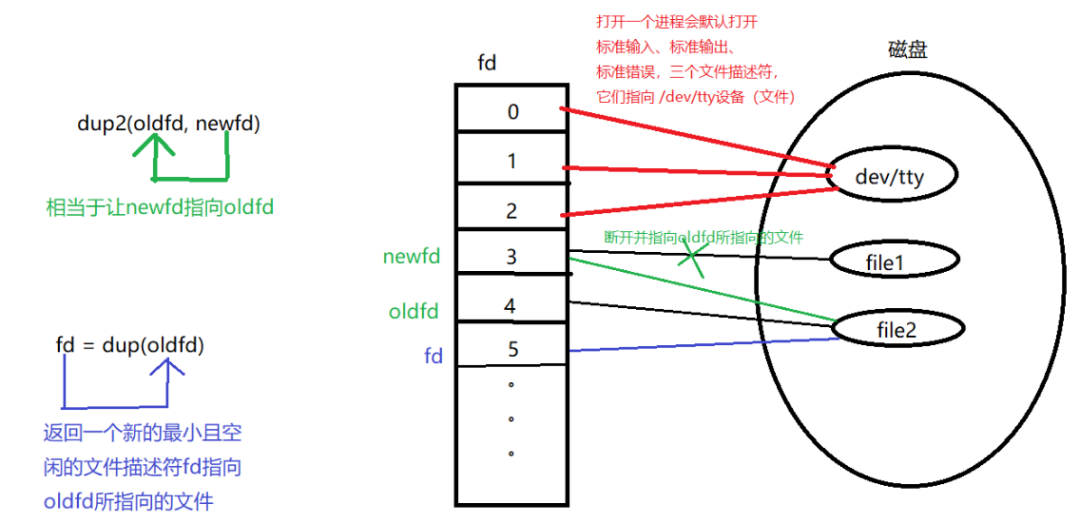【Linux系统调用API】七、errno()、strerror()、dup()、dup2()
【Linux系统调用API】七、errno()、strerror()、dup()、dup2()

mindtechnist
发布于 2024-08-08 17:07:52
发布于 2024-08-08 17:07:52
文章被收录于专栏:机器和智能
1. 什么是errno
errno可以理解为一个全局变量,它存储了出错信息。在下面三个路径可以看到errno相关的内容
/usr/include/errno.h
/usr/include/asm-generic/errno-base.h
/usr/include/asm-generic/errno.h我们可以在这些文件中自己定义一些errno,这样可以做到我们自己知道原始错误信息,而打印出来给用户看的是我们希望用户看到的对原始错误的解释。
2. strerror()函数
- 包含头文件
#include <string.h>- 函数原型
char *strerror(int errnum);- 函数功能 可以打印errno对应的详细错误信息。The strerror() function returns a pointer to a string that describes the error code passed in the argument errnum, possibly using the LC_MESSAGES part of the current locale to select the appropriate language. This string must not be modified by the application, but may be modified by a subsequent call to perror(3) or strerror(). No library function will modify this string.
- 函数参数
- errnum:错误编号
- 函数返回值 The strerror() functions return the appropriate error description string, or an "Unknown error nnn" message if the error number is unknown. 返回错误信息。
3. dup()和dup2()函数
- 包含头文件
#include <unistd.h>- 函数原型
int dup(int oldfd);
int dup2(int oldfd, int newfd);
#define _GNU_SOURCE
#include <unistd.h>
int dup3(int oldfd, int newfd, int flags);- 函数功能 这两个函数主要用于重定向,它们两个的功能和区别就是:

- dup(oldfd):复制文件描述符,返回一个当前空闲的最小文件描述符,并且让这个文件描述符指向oldfd所指向的文件;dup() uses the lowest-numbered unused descriptor for the new descriptor.
- dup2(oldfd, newfd):重定向,关闭newfd对应的文件使文件描述符newfd空闲,然后让newfd指向oldfd所指向的文件;dup2() makes newfd be the copy of oldfd, closing newfd first if necessary, but note the following: If oldfd is not a valid file descriptor, then the call fails, and newfd is not closed. If oldfd is a valid file descriptor, and newfd has the same value as oldfd, then dup2() does nothing, and returns newfd.
- 函数参数
- oldfd:旧的文件描述符
- newfd:新的文件描述符
- 函数返回值
- On success, these system calls return the new descriptor.
- On error, -1 is returned, and errno is set appropriately.
示例:一句话打印两次,先打入文件,后打至屏幕
/************************************************************
>File Name : dup_test.c
>Author : QQ
>Company : QQ
>Create Time: 2022年05月17日 星期二 16时09分41秒
************************************************************/
#include <stdio.h>
#include <stdlib.h>
#include <unistd.h>
#include <sys/types.h>
#include <fcntl.h>
int main(int argc, char* argv[])
{
if(argc < 2)
{
printf("not found string\n");
return -1;
}
/*每开启一个进程,默认打开 0 1 2 三个文件描述符*/
/*首先备份标准输出*/
int stdoutfd = dup(STDOUT_FILENO);
/*打开一个文件*/
int fd = open("hello.txt", O_WRONLY | O_CREAT, 0644);
/*重定向标准输出1至文件*/
dup2(fd, STDOUT_FILENO);
printf("first: %s\n", argv[1]);
/* ===========================
printf会进行系统调用,需要刷新buffer
===========================
fflush(stdout);
*/
/*恢复标准输出*/
dup2(stdoutfd, STDOUT_FILENO);
printf("second: %s\n", argv[1]);
close(fd);
return 0;
}我们编译运行一下,你会发现两次都打印在了屏幕上,其实这就是我们在《系统API与C库函数的调用关系》中讲的系统调用问题,C库函数printf()会调用系统API函数write(),这是会用到一个文件指针,这里面有一个缓冲区buffer,要打印的内容会先放入到buffer中,如果我们在第一次调用printf()函数后不刷新这个buffer缓冲区的话,在第二次打印的时候,buffer就会保留有上次调用时放入缓冲区的内容,所以打印到标准输出时,打印了两句话。
注意:这里的 "hello\ linux" 中,"\ " 使通过转义符把空格的特殊含义去掉,如果不加转义符,shell会把空格分开的内容当作两个字符串,通过转义符就可以实现在字符串中写入空格,这是shell的知识。

解决方法就是在第二次打印前刷新一下缓冲区,将上面代码中的fflush()函数放出即可

本文参与 腾讯云自媒体同步曝光计划,分享自微信公众号。
原始发表:2024-02-03,如有侵权请联系 cloudcommunity@tencent.com 删除
评论
登录后参与评论
推荐阅读
目录
